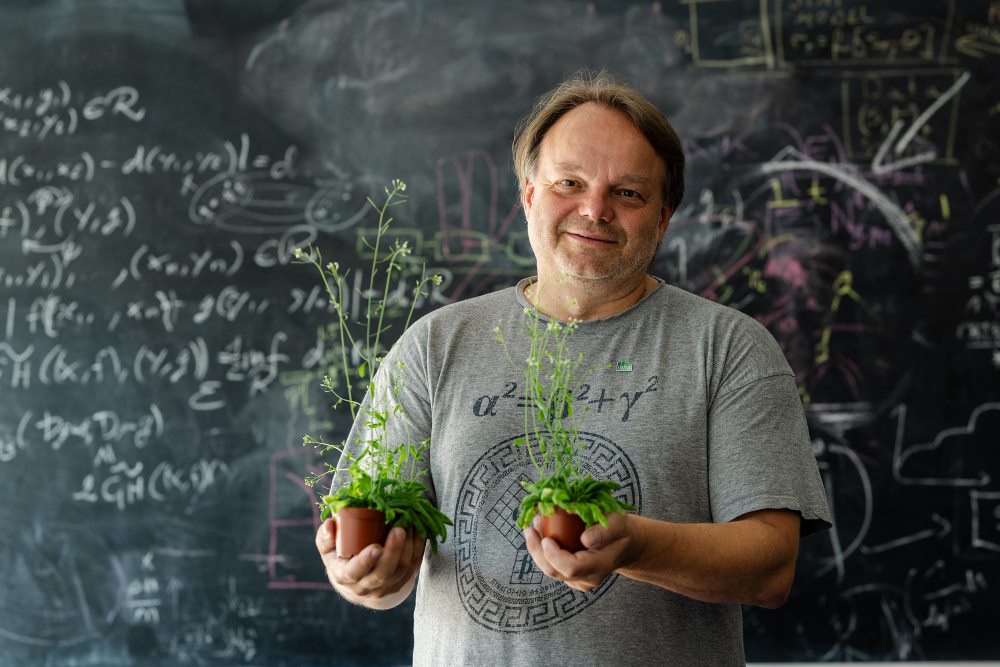May 19, 2025
How Roots Forage for Water
In drought conditions, plants do not care about gravity
Roots ‘feel’ gravity to extend and anchor themselves in the soil, but they can alter their growth direction toward a water source when needed. However, according to a new study by scientists at the Institute of Science and Technology Austria (ISTA) and Northwest A&F University in China, this change is promoted by drought conditions, which suppress the roots’ gravity-sensing ability. These insights could be useful for developing plants capable of withstanding extreme weather conditions.

Plants are constantly growing, responding to environmental signals and adjusting their development accordingly. They stretch their shoots toward the sun through a process called phototropism and extend their roots with the help of the Earth’s gravitational pull—a phenomenon known as gravitropism. Additionally, plants bend their roots towards damp areas in the soil, ensuring the plant’s access to water, a behavior called hydrotropism.
While phototropism and gravitropism are relatively well-documented and have been studied for more than a century, less is known about hydrotropism—even though it is crucial for plants, particularly in times of climate change.
A recent study by 2024 Wittgenstein Prize winner and Professor Jiří Friml and PhD student Adrijana Smoljan, both from the Institute of Science and Technology Austria (ISTA), and colleagues from Northwest A&F University in China, has unveiled new insights. The research shows that water foraging requires inhibition of gravitropism by hydrotropism master regulator “MIZ1.” Their findings are published this week in PNAS.
Getting rid of gravity
To delve deeper into hydrotropism, Friml and co. were eager to understand what happens when gravity no longer influences the root growth. Essentially, they aimed to get rid of gravitropism entirely. One option involves sending plants into space, such as NASA’s VEGGIE experiment or the European Space Agency’s (ESA) initiatives to cultivate plants in space.
However, for their research, the scientists chose to remain on Earth, using an approach by placing Petri dishes with A. thaliana seedlings on a slowly rotating platform. The continuous rotation constantly alters the direction of gravity, leaving the plant unable to respond to gravity because it cannot discern its source. Friml compares this to a clock, where the plant roots rotate like the clock hands.

“By eliminating gravity, we see that the hydrotropism becomes much stronger,” explains Friml. “Under normal conditions with sufficient water, gravitropism usually prevails. However, when you switch off gravitropism, the effects of hydrotropism become evident.”
In drought conditions, plants prioritize water over gravity
Next, the scientist discovered that during drought, plants inherently begin to suppress the gravitropism to some extent. “It makes sense,” explains Friml. “Finding water suddenly becomes more crucial than continuing to grow downward, so under drought conditions gravitropism is reduced, allowing plants to become more hydrotropic.”
But what triggers this shift from gravitropism to hydrotropism? A protein known as MIZ1 caught the scientists’ attention. Identified by Japanese scientists decades ago, MIZ1 is one of the very few genes that are known to be important for hydrotropism.
The researchers compared existing mutant plants lacking MIZ1 to wild-type (‘normal’) plants. They discovered that in MIZ1 mutants, the suppression of gravitropism in response to drought is not working. The plants showed a hydropic defect, with gravitropism still going strong. In essence, without MIZ1, plants struggle to search for water, as MIZ1 helps attenuate root gravitropism.
Water foraging and climate change
Understanding how plants find water and respond to droughts is crucial, especially amid climate change. “For example, last winter in Vienna was particularly dry,” explains Adrijana Smoljan. “This winter, the Hohe Warte weather station recorded just 32 liters of precipitation per square meter, significantly lower than the usual 130 liters. Consequently, the soil became very dry, heightening the risk of forest fires, even in winter.”
Such extreme weather conditions underscore the significance of the Friml group’s research. The more we understand how plants forage for water, the more we can help develop plants that can handle drought better—a vital step for agriculture. “By identifying corn or wheat variants with highly active MIZ1 protein, these can be introduced into the high yield variants. Theoretically, you could end up with more hydrotropic plants, which may improve their water uptake during droughts,” Friml adds.
Publication:
Y. Zhang, Z. Bao, A. Smoljan, Y. Liu, H. Wang & Jiří Friml. 2025. Foraging for water by MIZ1-mediated antagonism between root gravitropism and hydrotropism. PNAS. DOI: 10.1073/pnas.2427315122
Funding information:
This ISTA part of the project was supported by funding from the European Union’s Horizon 2020 research and innovation Programme (European Research Council grant agreement number 101142681, CYNIPS), Austrian Science Fund (FWF, grant number I 3630-B25), the Institute of Science and Technology Austria Fellow program, and the DOC fellowship by ÖAW (Austrian Academy of Sciences).



